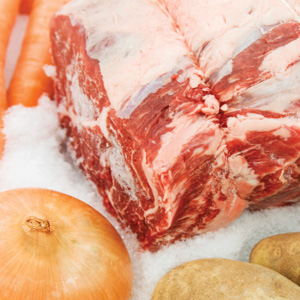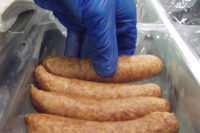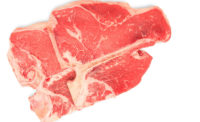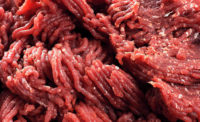
|
During the forming process, there are two points of concern, one is in properly filling the mold cavity of the forming machine to produce a product of consistent shape and size, and the other is maintaining that desired shape of the formed product as it is delivered to the conveyor belt for freezing or cooking. The viscosity of the meat mixture seems to be the most important characteristic of the meat mixture for successfully forming these products.
Processors can control the viscosity of these products before the forming process begins. Salt and fat content of the meat mixture, as well as the meat temperature, are three key factors in producing a desirable viscosity to optimize the machinability of meat mixtures in the forming equipment, as well as the resulting texture and shape of formed products.
The length of mixing and holding times after mixing, plus the intensity of the mixing process, also affect the viscosity of meat mixtures. In addition to these meat viscosity factors, the forming process can also be further controlled by the pumping pressure and the incorporation of air into the mixture during the forming process.
In reducing sodium in meat products, many companies may partially replace sodium chloride with potassium chloride, which wouldn’t likely cause much change in the forming process.
However, with the renewed interest today in not replacing sodium chloride with potassium chloride, but using other ingredients to enhance flavors and other processes to maintain bind, this change should not be a problem. In fact, the forming process should be easier with reduced sodium levels, as the viscosity would be reduced to levels more similar to unsalted meat.
A reduced viscosity means that the mixture would be softer, or less thick. With this approach to lowering sodium levels, product temperatures and pumping pressures might need to be reduced slightly in response to the lower viscosity.
In the case of reducing fat in meat products, if the fat content of a meat mixture is reduced, without compensating for the fat by adding water and extenders to the mixture, the viscosity of the mixture would be lower, making this mixture easier to fill the cavity of the forming machine than with meat of higher fat contents. However, because of the lower viscosity of the mixture, it would be more difficult to maintain the shape of the formed product, particularly when forming products at faster speeds. One solution would be to reduce the temperature of the lean mixture to increase its viscosity. Reducing the fat content without the addition of water and extenders will result in a firmer, more rubbery texture to the final cooked meat product, so that option is not likely to be as favorable to most consumers.
For leaner products, in which the fat is replaced with water and extenders, the meat viscosity could be increased to a more desirable level for the forming process, while softening the texture of the cooked product. We know that isolated soy protein, sodium caseinate, and corn starch will increase the viscosity of a lean mixture, and that the non-meat ingredients and water levels could be adjusted until the proper viscosity is achieved. Most ingredients that are available for binding water in meat products will increase the viscosity of the mixture. However, Kappa-carrageenan has not been shown to increase viscosity of meat mixtures. Also, alkaline phosphates will reduce the viscosity of meat mixtures, so be careful when using phosphates in products that are to be formed.
In summary, producing reduced fat and salt products doesn’t cause significant challenges for forming meat products, beyond what processors deal with in their traditional products.







Report Abusive Comment